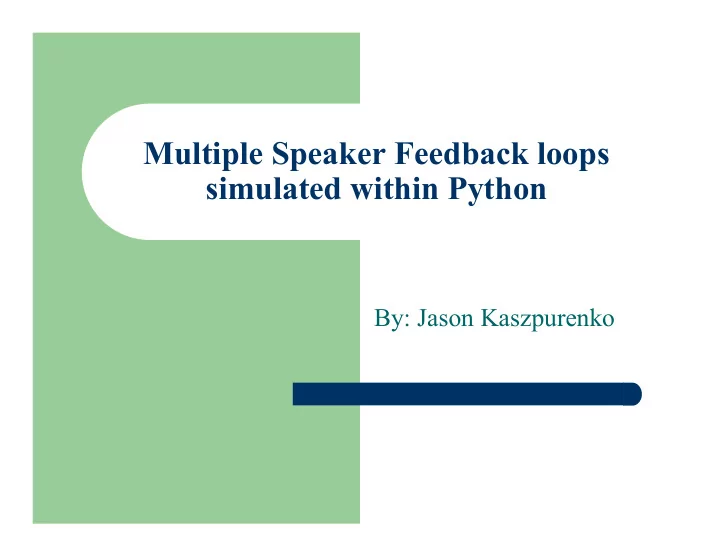

Multiple Speaker Feedback loops simulated within Python By: Jason Kaszpurenko
Overview System setup Ways to model it Some of the results Butchering of music Questions
System layout Multiple speakers at different distances from the microphone There could be n-speakers in the system Although not explored there could also be m-microphones in the system The Feedback Loop is not contained to be any one function (amplification, logistic map…) In theory you could make your own chorus/accapella with this setup
Modeling of the system Choose a simplest approach model to the system, viewing the distance as a time it takes for the sound to arrive at the microphone An initial signal will be inputted after that no other signal will be inputted
Modeling continued: If we call g(t) our microphone signal being received at a given time, τ being our delay and f(t) our original signal h(x,y) will return 0 if y < 0 otherwise it will perform an operator of our choosing on x We obtain the following expression = � g ( t ) h ( g ( t ), t ) f ( t ) � � � � + i i i i
Some of the results For a simple feedback circuit of r*signal The first attempts show that we have an unstable fixed point at with two speakers r = 0.5 converging to some none-zero value at t = infinity, values less than 0.5 converge to zero and values greater than 0.5 go to infinity With three speakers the fixed point seems to move to r = 4/3 There is evidence that a signal will also exhibit patterns of its inherited seeded signal such as a ramp function being evident as it explodes to infinity
3 Speaker ramped results: Duration of the ramped initial signal was doubled. Also note that the second chart was run longer.
Logistic map findings When we pass our signal through the logistic map we have different findings We have another fixed point around r = 1.5 (in my case), for values less it converges and greater than it explodes But there is a region in which the fixed point neither explodes or converges for a 3 speaker setup, 1 < r < 1.4
3 Logistic results: Second graph was run 50 times longer than the first so we could view the final state would be more emphasized
Some sounds I’m going to play a 3 speaker setup with just a constant being multiplying it Next I will butcher a classic piece of rock n roll in the name of science
Questions I would also like to thank Benny Brown and Ryan James for their help throughout the quarter
Recommend
More recommend